Sports
How Many Hockey Players Are On A Team?
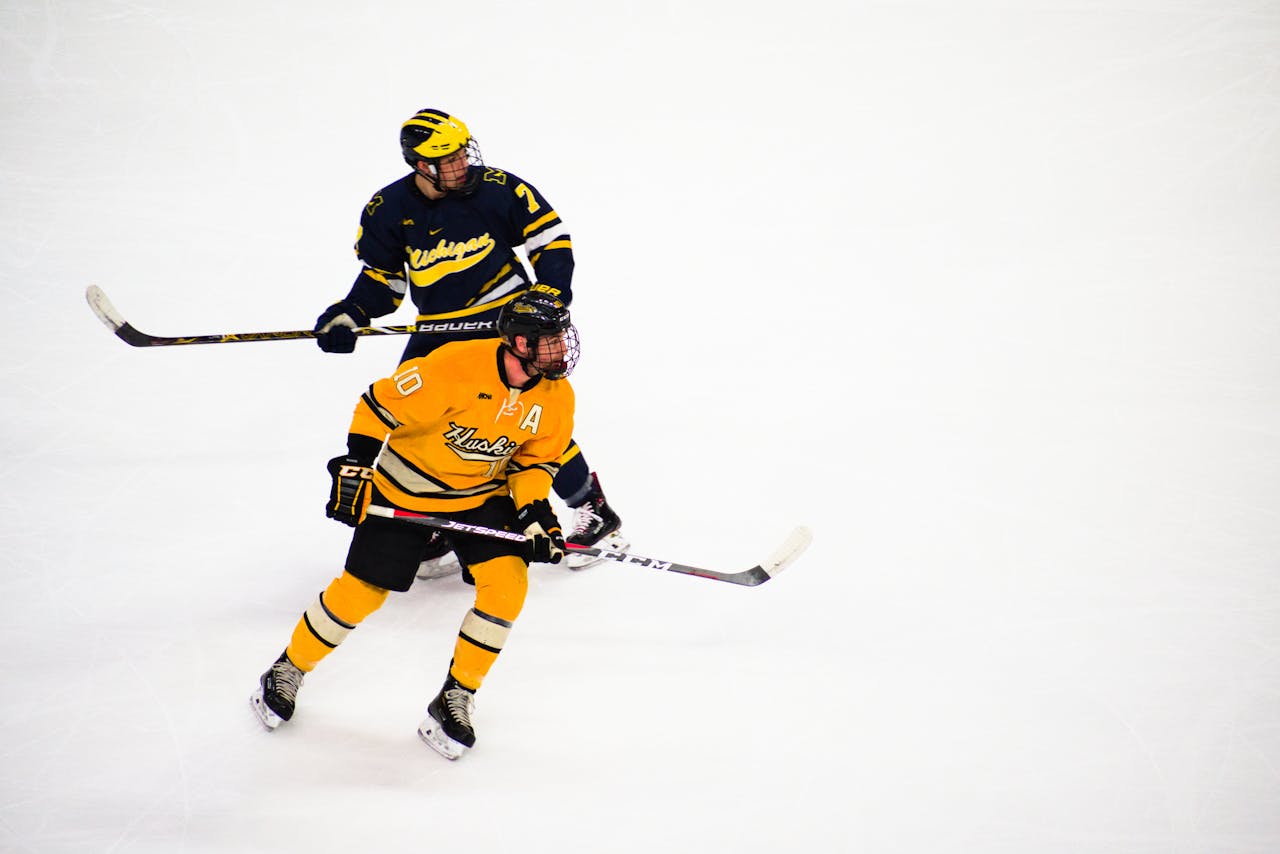
The sport is among the most exciting games played around the world; the game involves speed, strategy, and a lot of skills combined together in this activity. The most frequently asked question that comes to new people in this sport, fans, and players alike, is how many players does a hockey team have. In this article, the makeup of a hockey team, on-ice setup, roster size, strategic considerations, the role of players, and regulations are all put into discussion.
Team Composition in Hockey
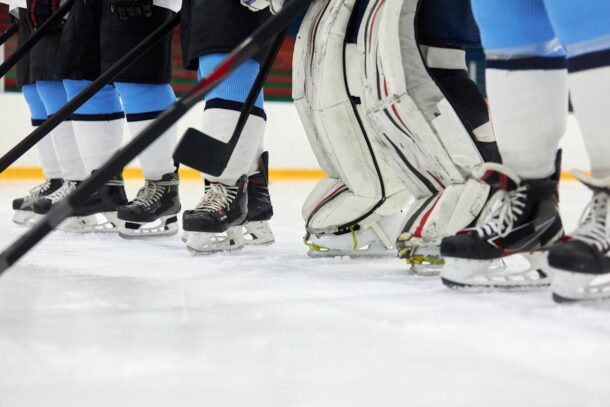
Understanding the basic composition of a hockey team is a pre-requisite to the appreciation of the game.
Number of Players on the Ice
There are six players from each team on the ice at a time in ice hockey:
- Goaltender: The last line of defense responsible for keeping the puck out of the net.
- Defensemen: These guys play at the blue line or in the defensive zone and their role is to block the opponents and assist the goalie.
- Forwards: Center, left wing, and right wing, these guys are more involved with scoring and setting up the offensive play most of the time.
So this provides an offensive/defensive balance as all players cycle on and off the ice through the course of a game.
Also Read About: Is Ice Skating Harder Than Roller Skating?
Roster Size
The National Hockey League functions with a maximum of 23 players on a roster per team in the regular season. This accounts for both the active and reserve lists.
- Active Roster: Each team shall dress 20 players for games: 18 skaters and 2 goaltenders.
- Reserve Players: All the other remaining players, whether to be used as substitutes, in an emergency, but not playing every match.
Under certain circumstances—playoffs or other international events, like pandemics—teams are allowed to carry additional players on the roster, including “taxi squad” members in reserve to be activated in case of sudden changes.
Player Positions and Responsibilities
Every hockey player has a role that contributes to the overall strategy of the team. Let’s break these roles down:
- Forwards: The forwards are the offensive players. Their job is to score goals and to create opportunities. Good forwards should have excellent skating, puck-handling, and communication skills to execute the offensive game properly.
- Center: Often considered the playmaker, the center supports the movement of the puck and organizes the attack.
- Wingers (Left and Right): These players focus on scoring and pressuring the opponent’s defense. Wingers also help with defensive duties when necessary.
- Defensemen: Defensemen are the backbone of the team’s defense. Their main roles include blocking shots and intercepting passes. They also keep the opponents out of the slot by protecting the goalie. They also help the offense in keeping the puck in the attacking zone
- Goaltender: The goaltender, or goalie, is arguably the most important player on the ice. His main responsibility is to keep the puck out of the net, which requires lightning-fast reflexes, good positioning, and the ability to read plays.
Also Read: Hockey Skates vs Figure Skates: What’s The Difference
Roster Composition Regulations
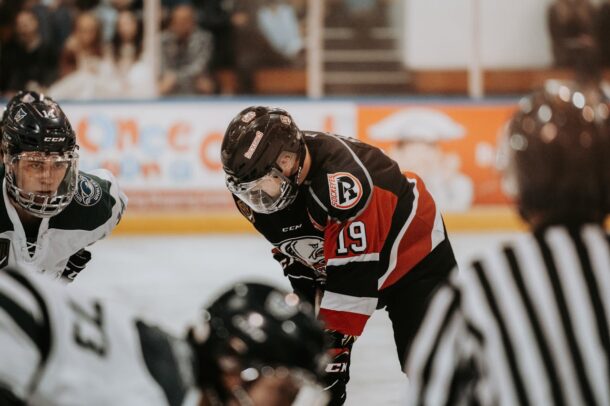
The composition of a hockey team is controlled by several rules and regulations impacting roster size, player management, and game-day lineups.
Salary Cap
Professional leagues, such as the NHL, impose a salary cap in order to ensure competitive balance. Teams must carefully work within their budgets and balance the contracts of superstar players with maintaining depth across the roster.
Waivers and Transactions
Waivers help the teams to assign players to minor leagues so that other teams can claim them. It helps to keep active the environment where the players can shift between teams following certain procedural parameters.
Playoff Roster Rules
Teams are able to call up extra players in order to expand the roster for playoffs, often referred to as “black aces.” These players would add depth and be well-placed to step in and play in big games.
Special Teams Tactics
Hockey is not about how many bodies are on the ice; the game involves much strategy, most especially during peculiar times such as power plays and penalty kills.
Power Play
A power play is when the other team has a player in the penalty box, and your team has an advantage numerically. Common tactics include:
- Formations such as the 1-3-1, which create open shooting lanes.
- Positioning players around the net to obstruct the goalie’s line of sight and tip shots in.
Penalty Kill
When your team is a man down due to a penalty, defense is the focus. Key penalty kill tactics include:
- Forming a box or diamond shape to defend the goal area.
- Blocking shots and intercepting passes to limit chances of scoring.
Also Read: Hockey Rink Size: How Big is an Ice Hockey Rink?
Gameplay Dynamics and Adjustments
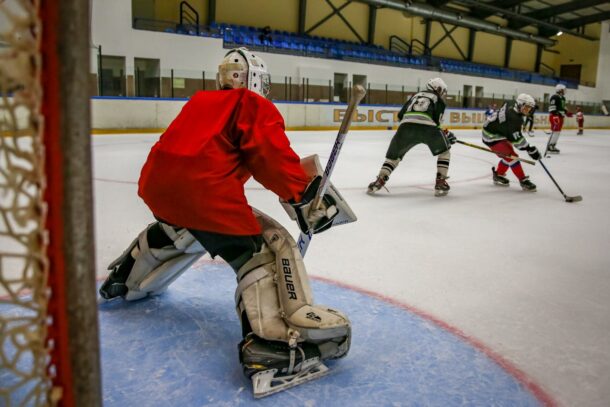
Hockey is a dynamic game, and adjustments are continually made to maximize performance levels.
Line Changes and Rotations
Players are constantly rotating on and off the ice to maintain energy levels at an optimum. These line changes take place every 30–90 seconds, depending upon the flow of the game.
Each Line:
- Consists of three forwards and two defensemen.
- Has a set rotation to ensure fresh legs are always on the ice at all times.
Injuries
Because hockey is such a physical sport and there are so many injuries, the backup players can prove invaluable, teams utilize and injured reserve list taking the player out of the current roster to open up that space for the replacement.
Hocklington: Hockey Across Formats
There are many forms of hockey played – field hockey and soccer come in different compositions.
Ice Hockey
- 6 on ice at any one time
- No limit to substitutions during game
Field Hockey
- 11 players on the team, goal keeper included
- Played on grass or artificial turf
Football
- 11 players on the field, goal keeper included.
- The number of substitutions is limited during games
Each version brings its own peculiarities and dynamics that define those respective games for them.
Football Frequently Asked Questions About Teams in Hockey
- How many players are on an NHL roster?
Ans: The maximum number of players an NHL team can have on its active roster is 23.
- How many players on the ice per game?
Ans: There are six players on the ice for each team: a goalie, two defensemen and three forwards.
- What happens when a player gets hurt?
Ans: The team can put the injured players on the IR list; in that case, they can replace those players temporarily . There are three periods in a game of hockey. A typical game of hockey will consist of three 20-minutes periods.
Post-Season and Playoff Considerations
Roster management becomes even more critical in the playoffs when teams dress 20 players per game, and expanded rosters allow for depth. The physicality of many playoff games lends itself to at least one tactical lineup change, based on the opponent and the conditions of the game.
Key Playoff Strategies:
- Rotating depth players to offset fatigue.
- Lineup juggling to offset opposing teams’ strengths.
Also Read: What Does MVR Mean In Baseball?
Women’s Hockey: Team Composition and Its Growing Popularity
Women’s hockey, thanks to events like the IIHF Women’s World Championship and the Winter Olympics, is extremely popular worldwide. The structure of a team in women’s hockey does not differ from men’s: six players skate on the ice at a time, one goaltender, two defensemen, and three forwards.
Roster size, under similar rules for women’s leagues like the PHF, is restricted to a minimum of 20 players and allows for a maximum of 23 players on an active roster to dress for regular-season games. Substitutions become very much part of the strategy in ensuring fresh legs on the ice to keep up with the pace of the game.
Women’s hockey has a different flavor, focusing on speed, skill, and finesse rather than physicality, since body checking is not allowed under most women’s hockey rules. That difference brings a tactical and technical aspect to the game, showcasing players’ agility, stick-handling, and playmaking abilities.
This has resulted in tremendous growth for women’s hockey, with so many more opportunities for players at both grassroots and professional levels. Those who follow the sport are rapidly coming to acknowledge the talent and dedication that these athletes bring onto the ice, accepting women’s hockey as an integral and celebrated part of the sport.
Also Read: Meet the Most Entertaining Pokémon YouTubers This Year [Top 15]
Conclusion
In conclusion, understanding how many hockey players are on a team is essential for appreciating the sport’s complexity and strategy. From the six players on the ice to the 23-player roster, every role and regulation contributes to the dynamic nature of hockey. Whether you’re a fan, player, or coach, this knowledge enriches your engagement with the game, offering deeper insights into its nuances.
Hockey is more than a game; it’s high-speed chess on ice, where every player is significant to their team’s success.

Sports
How Long Does It Take to Play 18 Holes of Golf?

Golf is a sport that requires patience, skill, and strategy. One of the most common questions among both beginners and experienced players is, “How long does it take to play 18 holes of golf?” The answer varies based on multiple factors, including player skill level, course layout, group size, and external conditions. In this article, we will explore the estimated time to complete 18 holes and the factors that influence the duration of a golf round.
How Long It Takes to Play 18 Holes of Golf
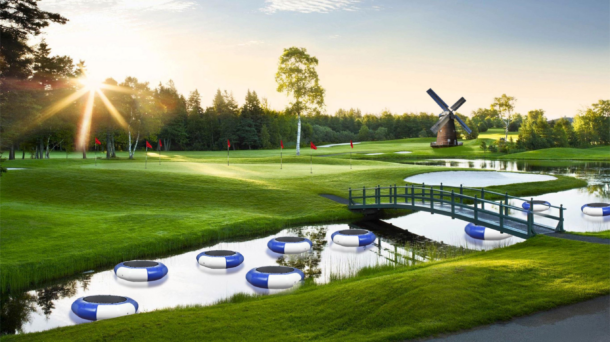
On average, an 18-hole round of golf takes approximately four to five hours to complete. However, this time can vary widely depending on different circumstances. A solo golfer or a twosome can usually finish in about three to four hours, while a standard foursome typically takes four to five hours. In tournament play, where precision and strategy take precedence, the duration can extend to five or even six hours.
Average Time to Play 18 Holes of Golf
The average time to play 18 holes of golf is typically between four to five hours. However, this duration varies depending on several factors such as group size, player skill level, course difficulty, and whether players are walking or using a golf cart.
- Solo players can finish in 2.5 to 3.5 hours, especially if using a golf cart.
- Twosomes usually take 3 to 4 hours due to alternating shots and potential waiting times.
- Foursomes, which are the most common group size, take 4 to 5 hours on average.
- Tournament play or professional rounds may extend to 5 to 6 hours, as players take more time for strategy and precision.
Factors Affecting Time to Complete 18 Holes of Golf
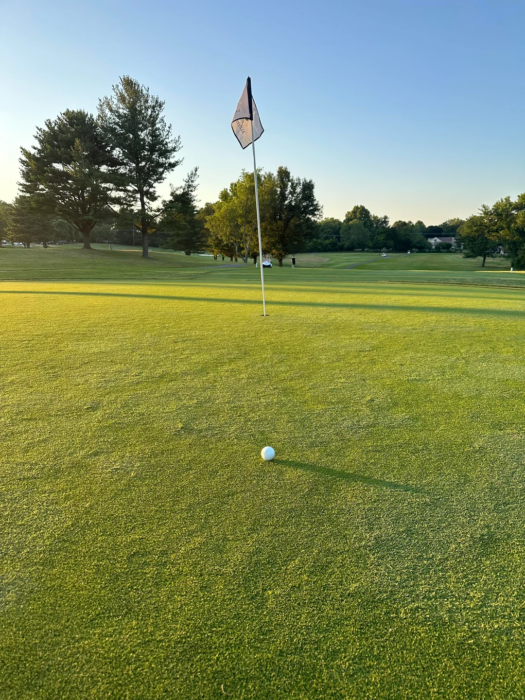
Group Size
The size of the group significantly impacts the overall time to play 18 holes. A solo player can complete a round much faster, often within three hours, since there is no waiting for others to take their shots. A twosome plays slightly slower, averaging three to four hours. A standard foursome, which is the most common setup, typically takes four to five hours due to the additional time needed for each player to complete their shots. If the course is crowded, the pace slows further as players wait for groups ahead to finish each hole.
Player Skill
Skill level plays a major role in determining the pace of play. Beginner golfers tend to take longer as they require more strokes per hole, frequently adjust their stance, and may spend time looking for lost balls. In contrast, experienced golfers play faster due to better accuracy and course management. Professional players, while skilled, may take longer in competitive settings due to strategic decision-making and strict adherence to rules.
Course Rating
The design and difficulty level of a golf course also impact the time required to complete a round. Courses with numerous hazards, long fairways, and complex greens naturally take longer to navigate. Shorter par-3 courses or executive courses require less time, making them ideal for quicker rounds. Additionally, the level of maintenance on the course, including green speed and rough conditions, can also affect the pace of play.
Walking or Riding
Whether a player chooses to walk or ride in a golf cart has a noticeable effect on the duration of the game. Walking the course adds travel time between shots and holes, making the round take longer—often closer to five hours. Riding in a golf cart significantly reduces the time needed to move between holes, cutting the total round time by 30 to 60 minutes.
How Long Does It Take to Play 18 Holes of Golf with 1 Person?
A solo golfer can complete 18 holes much faster than a group. On an uncrowded course, a single player can finish in about two and a half to three and a half hours. If using a golf cart, the time may be closer to two hours. However, course conditions and external factors, such as slow groups ahead, can still affect playtime.
How Long Does It Take 2 Players to Golf 18 Holes?
A twosome generally takes about three to four hours to complete 18 holes. Since there are only two players taking turns, the pace is faster than a standard foursome. If the course is busy, waiting for other groups may extend the playtime, but otherwise, a twosome can finish efficiently, especially with the use of a golf cart.
How Long Does It Take to Play 9 Holes of Golf with 4 Players?
Playing nine holes with a group of four golfers typically takes about two to two and a half hours. The pace is influenced by the same factors affecting an 18-hole round, including skill level, course difficulty, and whether players are walking or riding. A relaxed or beginner group may take closer to three hours.
How Many Holes of Golf Can You Play in 3 Hours?
The number of holes that can be played in three hours depends on group size, course conditions, and mode of transportation. A solo golfer with a cart can often complete 18 holes in about three hours. A twosome may complete 12-15 holes in the same time frame, while a foursome might finish around 9-12 holes, depending on pace and delays.
Conclusion
The time required to play 18 holes of golf depends on various factors, including player experience, group size, course difficulty, and transportation method. While the average duration is four to five hours, skilled golfers and smaller groups can complete a round in less time, especially with the use of a golf cart. Understanding these factors can help golfers plan their rounds effectively and optimize their time on the course.
Sports
Hockey Rink Size: How Big is an Ice Hockey Rink?
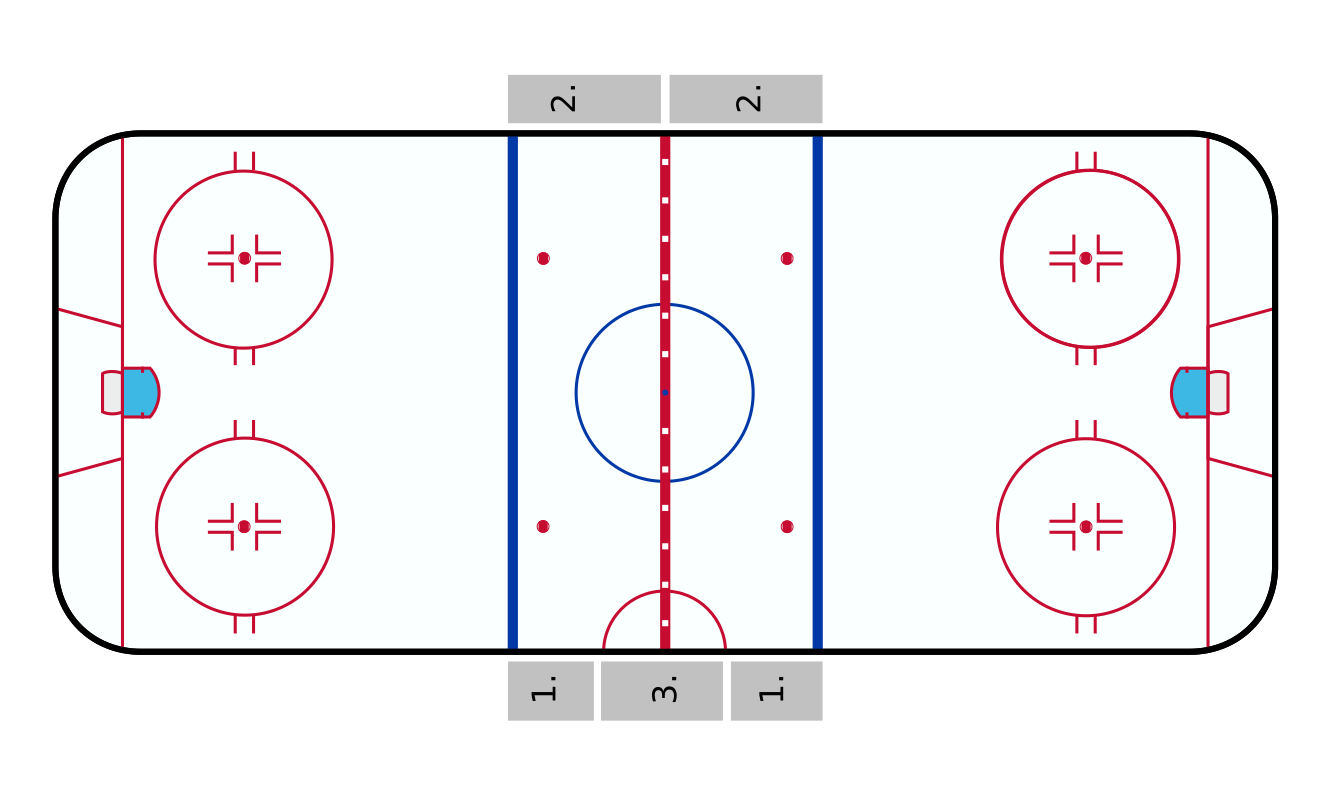
Ice hockey is a thrilling sport that combines speed, strategy, and skill. While fans may focus on the players and the puck, the size of the rink itself plays a crucial role in shaping the game. The dimensions of an ice hockey rink affect the pace of play, strategies employed by teams, and even the physicality of the game.
This article will answer all your questions about the intricacies of hockey rink dimensions, variations across leagues, and the impact of rink size on gameplay.
Standard Ice Hockey Rink Dimensions
An ice hockey rink is a rectangular sheet of ice with rounded corners, enclosed by boards to keep the puck in play and protect spectators. The dimensions of the rink can vary depending on the league and level of play, but there are two predominant standards: the North American (NHL) and the International Ice Hockey Federation (IIHF) sizes.
1. NHL Standard Rink
- Length: 200 feet (61 meters)
- Width: 85 feet (26 meters)
- Corner Radius: 28 feet (8.5 meters)
The National Hockey League (NHL) uses these dimensions, and they are widely adopted in North America. The narrower width and smaller overall size compared to international rinks create a more compact playing area. This encourages faster gameplay, tighter spacing, and more physical contact.
2. IIHF Standard Rink
- Length: 197 feet (60 meters)
- Width: 98.4 feet (30 meters)
- Corner Radius: 28 feet (8.5 meters)
The IIHF dimensions are used in international competitions, including the Olympics. The wider playing surface allows for more open play, emphasizing skill and speed over physicality. Teams must adapt their strategies when transitioning between these rink sizes, as the larger ice surface impacts positioning and pacing.
Also Read: Hockey Skates vs Figure Skates: What’s The Difference
Key Features of a Hockey Rink
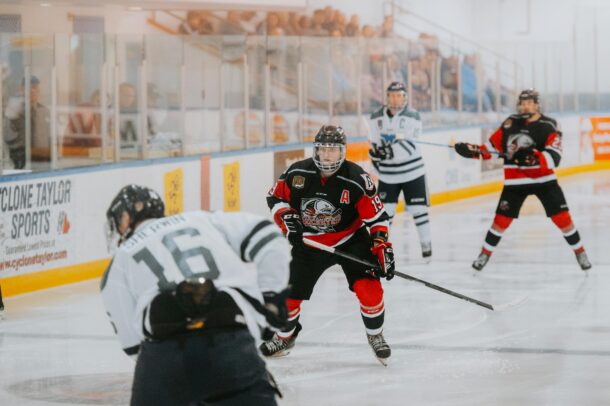
In addition to overall dimensions, an ice hockey rink is divided into distinct zones and features:
1. The Ice Surface
The ice is meticulously maintained and kept at a temperature of approximately −5°C (23°F) to ensure optimal skating conditions. Modern rinks use advanced refrigeration systems to keep the ice consistent throughout games.
2. The Zones
- Neutral Zone: The central area between the two blue lines. It is where the puck is dropped for faceoffs at the start of periods and after goals.
- Defensive Zone: The area in front of a team’s own goal.
- Offensive Zone: The area in front of the opposing team’s goal.
3. Goal Crease and Nets
- The crease is a semi-circular area in front of each goal, marked by a red line. It measures 8 feet wide and 4 feet deep (2.4 meters by 1.2 meters).
- The goals themselves are 4 feet high and 6 feet wide (1.2 meters by 1.8 meters).
4. Faceoff Circles and Spots
There are nine faceoff spots on the rink: two in each end zone, two in the neutral zone, and one at the center. Surrounding these are faceoff circles that help organize players during restarts.
5. Boards and Glass
The boards surrounding the rink are typically 4 feet high (1.2 meters), with protective glass extending another 5 to 8 feet (1.5 to 2.4 meters) above them. This setup keeps the puck in play and enhances spectator safety.
Also Read: Is Ice Skating Harder Than Roller Skating?
Variations in Rink Sizes
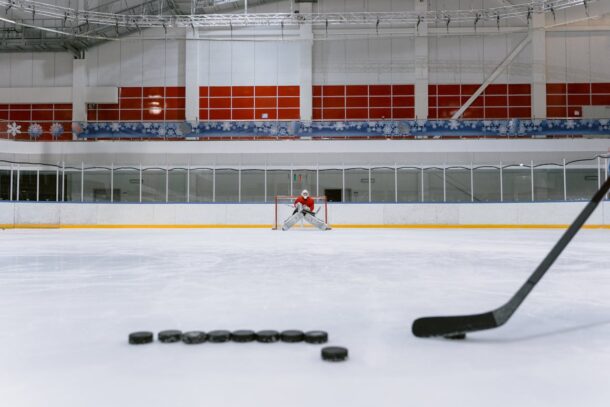
While the NHL and IIHF standards dominate professional hockey, there are several variations in rink sizes based on league requirements, recreational needs, and historical contexts.
1. Collegiate Hockey Rinks
College hockey in North America often uses rinks with dimensions that fall between NHL and IIHF standards. Some NCAA rinks are as wide as 100 feet (30.5 meters), providing a hybrid experience.
2. Recreational and Youth Hockey Rinks
Smaller rinks are common in recreational leagues and youth hockey. These rinks typically have:
- Reduced length and width to accommodate younger players.
- Shallower corner radii to simplify construction and gameplay.
3. Outdoor Rinks
Outdoor hockey rinks, often used for casual or pond hockey, vary widely in size and layout. Weather conditions can impact ice quality and the overall experience.
Also Read: What Does MVR Mean In Baseball?
Impact of Rink Size on Gameplay
The size of the rink has a profound effect on how the game is played. Here are some key considerations:
1. Pace and Physicality
- Smaller rinks, like those used in the NHL, result in faster, more aggressive games. Players have less time and space to make decisions, leading to frequent body checks and quick transitions.
- Larger rinks, such as those conforming to IIHF standards, allow players to spread out. This encourages a more methodical style of play, with greater emphasis on passing and positioning.
2. Scoring Opportunities
- The compact nature of NHL rinks creates more opportunities for quick shots and rebounds, contributing to higher-scoring games.
- In IIHF games, the increased space can make it harder to defend against skilled players, but it also gives goalies more time to react.
3. Player Skillsets
- NHL rinks favor players who excel in tight spaces, such as power forwards and defensemen adept at clearing the puck.
- IIHF rinks benefit players with exceptional skating ability and creativity, as they can take advantage of the extra space.
4. Strategies
- Teams playing on NHL rinks often employ forechecking systems to pressure opponents into making mistakes.
- On IIHF rinks, teams might prioritize zone entries and puck possession to create scoring chances.
Also Read: How Many Hockey Players Are On A Team?
The Evolution of Hockey Rink Sizes
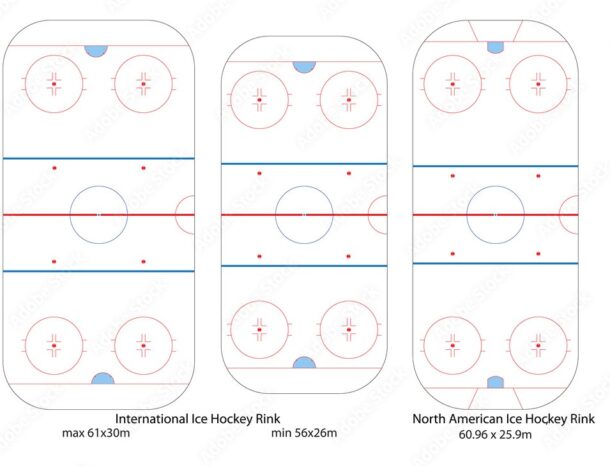
The dimensions of hockey rinks have evolved over time. Early rinks in the late 19th century were often irregularly shaped and sized, reflecting the challenges of constructing indoor ice surfaces. As the sport gained popularity, standardization became necessary.
The NHL adopted its current rink dimensions in the 1920s, influenced by the constraints of indoor arenas in North America. In contrast, European rinks, often built later, had fewer spatial limitations, allowing for wider playing surfaces. The IIHF standardized its dimensions in the mid-20th century to accommodate international tournaments.
Building and Maintaining an Ice Hockey Rink
Constructing an ice hockey rink is a complex process that requires careful planning and engineering:
1. Foundation and Cooling Systems
- A typical rink has a concrete or sand base embedded with a network of pipes.
- A refrigerant circulates through these pipes to keep the ice at the desired temperature.
2. Layering the Ice
- Ice is built up in thin layers, with each layer sprayed and frozen to ensure a smooth surface.
- The final layer is painted with white paint and markings, including lines and logos, before being sealed with more ice.
3. Maintenance
- Zambonis (ice resurfacers) are used between periods to clean and smooth the ice surface.
- Regular temperature checks and adjustments ensure consistency.
Also Read: Meet the Most Entertaining Pokémon YouTubers This Year [Top 15]
Fun Facts About Hockey Rink Sizes
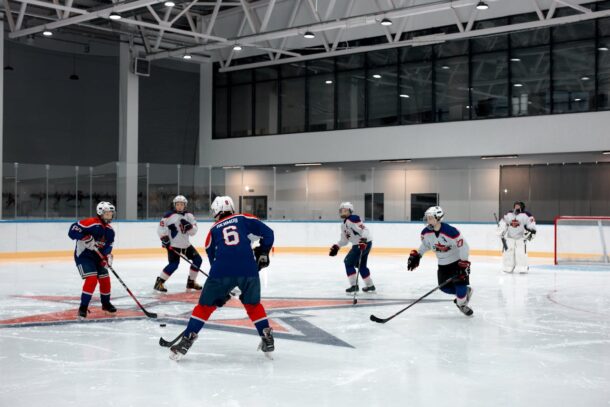
- Oldest Indoor Rink: The world’s oldest indoor ice hockey rink still in use is the St. Moritz Ice Rink in Switzerland, built in 1899.
- NHL Outdoor Games: The NHL has hosted outdoor games in non-standard venues, including football stadiums and baseball parks, requiring custom rink constructions.
- Largest Ice Rink: The Rideau Canal Skateway in Ottawa, Canada, spans nearly 5 miles (8 kilometers), but it’s used for recreational skating, not hockey.
- Multi-Purpose Venues: Many hockey rinks are part of arenas that host concerts, basketball games, and other events, requiring swift conversions.
Conclusion
The size of an ice hockey rink is more than just a technical specification—it’s a fundamental aspect of the game’s identity. Whether it’s the tight, action-packed style of NHL play or the graceful, expansive strategies seen on international ice, the dimensions of the rink shape every moment on the ice. Understanding these differences enhances appreciation for the sport and highlights the adaptability of players and teams.
From recreational leagues to the highest levels of competition, hockey rinks provide the stage for one of the most exciting sports in the world. No matter the size, the spirit of the game remains constant, captivating fans and players alike.
Sports
Hockey Skates vs Figure Skates: What’s The Difference
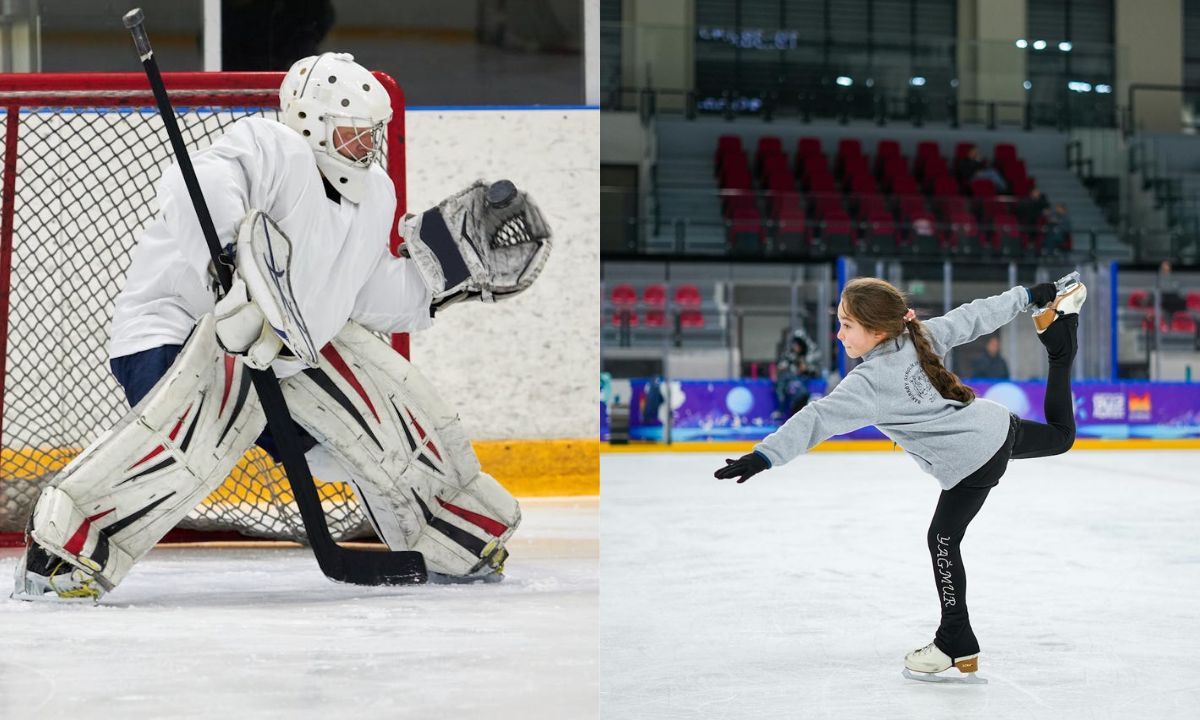
When stepping into the world of ice skating, one of the first choices you’ll face is deciding between hockey skates and figure skates. Each type of skate serves a unique purpose and caters to different styles of skating. Understanding their differences can help you make an informed decision, whether you’re a beginner or a seasoned skater. Let’s look into the key distinctions between hockey skates and figure skates.
Design and Structure
The design of skates plays a significant role in how they function. Hockey skates and figure skates differ in the specific demands of their respective activities.
Hockey Skates
Hockey skates are built for speed, agility, and protection. They have a low-cut design around the ankle, providing greater movement freedom. The boots are made from stiff, durable materials to protect the feet from impacts like pucks or sticks. The blades are shorter and curved at both ends, enabling quick turns and fast stops. The toe pick is absent, as it’s unnecessary for the rapid movements required in hockey.
The materials used in hockey skates are designed to withstand intense conditions. The stiff exterior protects against impacts, while the interior padding ensures comfort during long sessions on the ice. This combination of durability and comfort makes hockey skates suitable for the physical nature of the sport.
Figure Skates
Figure skates, on the other hand, prioritize grace and control. They have a higher boot design that offers ankle support for intricate movements and jumps. The blades are extended and straighter, providing more stability on the ice. One of the most distinctive features of figure skates is the toe pick — a serrated edge at the front of the blade. This is used for jumping and other technical manoeuvres in figure skating routines.
Figure skates are often crafted with aesthetics in mind. The sleek design and polished blades contribute to their elegance. The longer blades provide a smoother glide, essential for performing spins and other artistic elements. The high boot design also ensures stability, helping skaters maintain control during complex routines.
Also Read: Is Ice Skating Harder Than Roller Skating?
Purpose and Performance
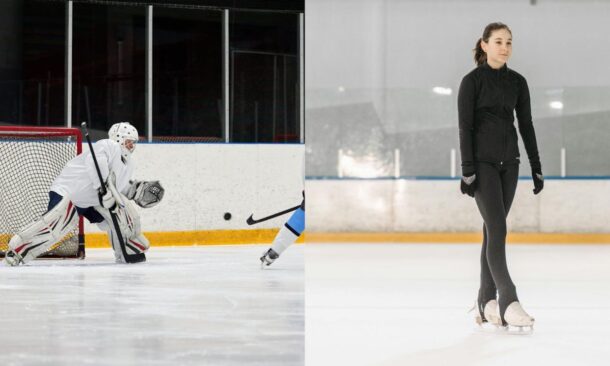
Skates are designed for specific activities. The performance of hockey and figure skates reflects their intended use on the ice.
Hockey Skates
Hockey skates are designed for the fast-paced, physical nature of hockey. Their lightweight construction allows players to accelerate quickly and change directions with ease. The shorter blades enhance mobility, making it easier to manoeuvre in tight spaces. Additionally, the rigid boot construction protects the feet during intense gameplay, where collisions and impacts are common.
The performance of hockey skates is optimized for agility. Players must make quick stops, start again rapidly, and move laterally without losing balance. These features make hockey skates a vital tool for athletes aiming to excel in this competitive sport.
Figure Skates
Figure skates are crafted for elegance and precision. The longer blades and toe picks enable skaters to perform spins, jumps, and other artistic movements. The high boot provides the necessary support for landing jumps and executing complex footwork. Figure skates are ideal for anyone interested in mastering the art of figure skating or ice dancing.
The balance provided by the longer blades makes figure skates well-suited for choreographed routines. Skaters can glide smoothly and perform intricate movements with confidence. The toe pick also adds versatility, allowing skaters to push off the ice for jumps or to control spins precisely.
Also Read: What Does MVR Mean In Baseball?
Fit and Comfort
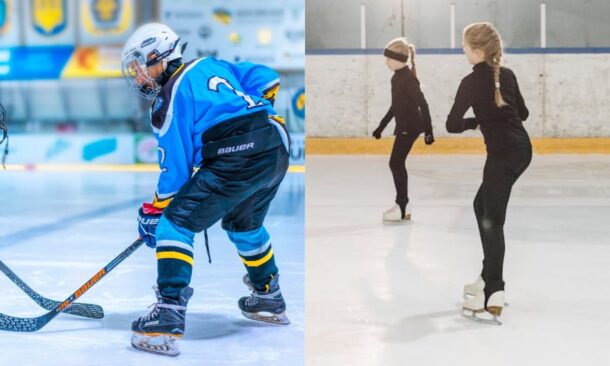
A good fit is crucial for performance and comfort. Both hockey skates and figure skates are designed to meet specific fitting requirements.
Hockey Skates
Hockey skates are designed to fit snugly around the foot, providing a secure feel. This close fit minimizes movement within the skate, enhancing control and responsiveness on the ice. However, breaking in hockey skates can be challenging, as the stiff materials may initially feel uncomfortable. Over time, the skates mould to the shape of your feet for a customized fit.
The snug fit of hockey skates is particularly beneficial during gameplay. A secure fit ensures that the skates move as an extension of the player’s body, improving overall performance. Although the initial break-in period may be uncomfortable, the long-term benefits outweigh this short-term inconvenience.
Figure Skates
Figure skates tend to fit more comfortably right out of the box. The boots are often padded for added comfort, especially around the ankles. While they may require some breaking in, the process is generally less intense than with hockey skates. A well-fitted pair of figure skates should feel snug but not overly tight, allowing precise movements without discomfort.
Comfort is a priority for figure skaters, as routines can involve prolonged periods on the ice. The padding inside figure skates helps absorb impact, making it easier to perform jumps and landings. Additionally, the design of figure skates ensures that skaters can maintain control without sacrificing comfort.
Also Read: Hockey Skates vs Figure Skates: What’s The Difference
Skill Requirements and Learning Curve
Learning to skate can be more straightforward or complex, depending on the type of skates. The design of hockey and figure skates affects the learning process differently.
Hockey Skates
For beginners, hockey skates can feel less stable due to their shorter blades. Learning to balance and stop on hockey skates may take more practice than figure skates. However, once you’ve mastered the basics, hockey skates offer greater versatility for fast, dynamic skating. They are excellent for developing quick reflexes and improving overall ice skating skills.
Hockey skates require skaters to develop firm ankle control and balance. This challenge can initially be frustrating but is ultimately rewarding. Once skaters become comfortable with hockey skates, they often find them more versatile for various ice activities beyond hockey.
Figure Skates
Figure skates’ longer blades provide more stability, making them a popular choice for beginners. The toe pick can be both a help and a hindrance. While it’s essential for advanced figure skating techniques, beginners may accidentally trip over it until they’re accustomed to its presence. Overall, figure skates are more forgiving for those new to the ice, allowing learners to build confidence while improving their balance.
Figure skates’ forgiving nature makes them ideal for beginners focusing on balance and technique. The stability provided by the longer blades helps skaters feel secure as they learn basic skills. As skaters progress, they can explore the artistic and technical aspects of figure skating.
Also Read: Meet the Most Entertaining Pokémon YouTubers This Year [Top 15]
Cost and Maintenance
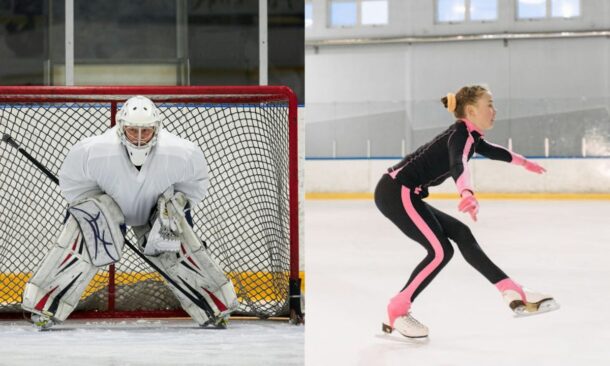
The cost of skates and the effort needed for maintenance are important factors to consider. Both hockey and figure skates come with unique requirements.
Hockey Skates
Hockey skates range in price from budget-friendly options to high-end models. The cost usually reflects the quality of materials and the level of protection offered. Regular maintenance is crucial, including sharpening the blades and checking for wear and tear. Since hockey is a contact sport, skates may require more frequent repairs.
Proper maintenance of hockey skates ensures optimal performance and longevity. Sharpening the blades regularly helps maintain control of the ice. Inspecting the boots and laces for signs of wear can prevent potential issues during gameplay. With consistent care, hockey skates can last for several seasons.
Figure Skates
Figure skates also vary in price, depending on the brand and features. High-quality figure skates designed for competitive use can be pretty expensive. Maintenance involves blade sharpening and keeping the boots clean and dry. Proper care ensures the skates remain functional and aesthetically pleasing for performances.
Figure skates require a gentle approach to maintenance to preserve their elegant appearance. Cleaning the boots after each session prevents damage from moisture and debris. Sharpening the blades ensures smooth gliding and precise movements. With proper care, figure skates can retain their performance and visual appeal for years.
Choosing the Right Skates
The right pair of skates can significantly improve your skating journey. Your choice should align with your goals, interests, and skill level.
Consider your goals and interests when deciding between hockey and figure skates. If you’re drawn to the speed and excitement of hockey, hockey skates are the way to go. If you’re captivated by the elegance of figure skating, figure skates are the better choice. Consider the type of skating experience you’d like to pursue and choose accordingly.
For beginners unsure of their preferences, it’s worth trying both types of skates before making a purchase. Renting skates at a local rink is an excellent way to get a feel for each style. Once you’ve identified your skating goals, invest in a quality pair of skates that align with your needs.
Conclusion
Hockey and figure skates serve distinct purposes and are tailored to different styles of skating. Hockey skates prioritize speed, agility, and protection, while figure skates focus on grace, precision, and artistry. By understanding the differences between these two types of skates, you can choose the pair that best suits your skating aspirations. Whether gliding across the ice in a hockey game or performing a graceful routine, the right skates will enhance your experience and help you shine on the ice.
-

 Guides5 years ago
Guides5 years ago6 Proven Ways to Get more Instagram Likes on your Business Account
-

 Mainstream6 years ago
Mainstream6 years agoHow to Buy Property & Safe Houses in GTA 5 (Grand Theft Auto 5)
-

 Mainstream10 years ago
Mainstream10 years agoBioWare: Mass Effect 4 to Benefit From Dropping Last-Gen, Will Not Share Template With Dragon Age: Inquisition
-

 Casual1 year ago
Casual1 year ago8 Ways to Fix Over-Extrusion and Under-Extrusion in 3D Printing
-
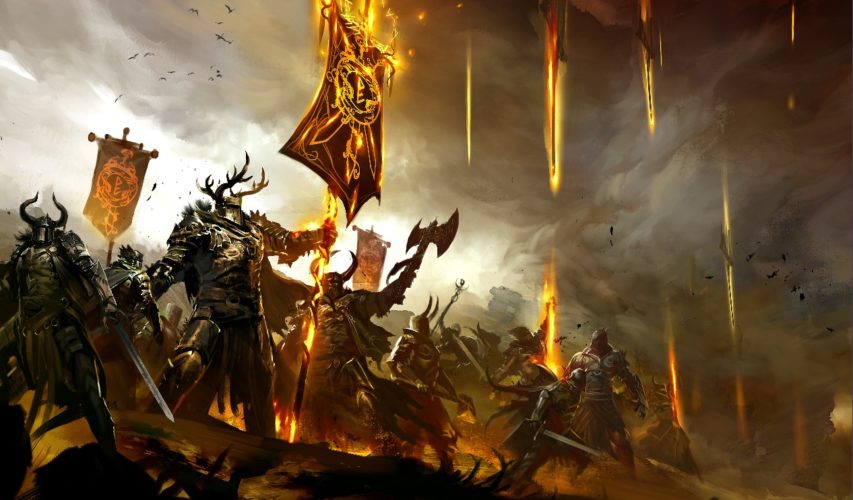
 Mainstream12 years ago
Mainstream12 years agoGuild Wars 2: The eSports Dream and the sPvP Tragedy
-

 Uncategorized4 years ago
Uncategorized4 years agoTips To Compose a Technical Essay
-

 Guides1 year ago
Guides1 year agoExplore 15 Most Popular Poki Games
-

 iOS Games2 years ago
iOS Games2 years agoThe Benefits of Mobile Apps for Gaming: How They Enhance the Gaming Experience